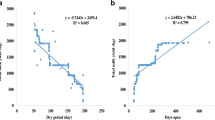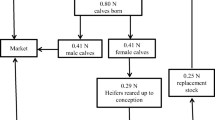Abstract
In order to enhance the profitability of dairy buffaloes, it is necessary to develop an understanding of the factors affecting their reproduction and milk production ability. Thus, the objective of this study was to elucidate the economic impacts of calving season and parity on reproduction and production indices of Egyptian dairy buffaloes (1180) reared under subtropical environmental conditions. Buffaloes calving in the autumn season had lesser days open, calving interval, and service per conception (108.25 days, 414.16 days, and 1.67, respectively), while spring calvers showed the greater calculations (210.27 days, 522.82 days, and 2.39, respectively). The buffaloes calving for the first time had the longest days open, calving interval, and number of services per conception among different parities (176.21 days, 490.05 days, and 2.18, respectively), then decreased thereafter. Furthermore, buffaloes calving in the winter season had the significantly highest total milk yield, milk revenue, total revenue, profit, and profit/cost ratio (1981.4 kg, 1769.1 $, 2019.5 $, 662.9 $, and 0.49, respectively) in comparison with other seasons. The total milk yield, lactation period, profit, and profit/cost ratio were increased to reach the peak values in the fourth parity (2051.5 kg, 252.44 days, 674.8 $, and 0.48, respectively), then decreased thereafter. In conclusion, buffaloes at the fourth parity and those calving in the winter season had the best milk yield, milk revenue, total revenue, and profit/cost ratio. Therefore, breeders must pay more attention to calving season and parity as they play an important role in the farm profitability and productivity and should counteract the adverse effects of periodical and seasonal changes. It is recommended to make estrus synchronization for more calvings in the winter season. Finally, choose the best lifetime for keeping the animal in production.






Similar content being viewed by others
References
Abayawansa WD, Prabhakar S, Singh AK, Brar PS (2011) Effect of climatic changes on reproductive performance of Murrah buffaloes in Punjab: a retrospective analysis. Indian Journal of Animal Sciences 81:334–339
Ali A, Javed K, Ahmad N, Rehman SU (2011) Environmental factors affecting some reproductive traits in Nili Ravi buffaloes. The Journal of Animal & Plant Sciences 21:868–871
Aziz MA, Schoeman SJ, Jordaan GF, El-Chafie OM, Mahdy AT (2001) Genetic and phenotypic variation of some reproductive traits in Egyptian buffalo. South African Journal of Animal Science 31:195–199
Bampidis AV, Nistor E, Skapetas VB, Christodoulou V, Chatziplis D, Mitsopoulos I, Lagka V (2012) Effect of parity and calving month on milk production and quality of Greek buffalo (Bubalus bubalis). Animal Science and Biotechnologies 45:216–220
Bashir MK, Khan MS, Bhatti SA, Iqbal A (2007) Lifetime performance of Nili-Ravi buffaloes in Pakistan. Asian Australas J Anim Sci 20:661–668
Bashir MK, Khan MS, Lateef M, Mustafa MI, Khalid MF, Rehman S, Farooq U (2014) Environmental factors affecting productive traits and their trends in NiliRavi buffaloes. Pakistan Journal of Life and Social Sciences 25:1–7
Bashir MK, Khan MS, Lateef M, Mustafa MI, Khalid MF, Shahid-ur-Rehman, Farooq U (2015) Environmental factors affecting productive traits and their trends in Nili-Ravi buffaloes. Pakistan Journal of Life and Social Sciences 13:137–144
Bufano G, Carnicella D, De Palo P, Laudadio V, Celano G, Dario C (2006) The effect of calving season on milk production in water buffalo (Bubalus bubalis). Arch Latinoam Prod Anim 14:60–61
Chakraborty D, Dhaka SS, Pander BL, Yadav AS (2010) Genetic studies on production efficiency traits in Murrah buffaloes. Indian Journal of Animal Science 80:898–901
Devaraj M, Janakiraman K (1986) Postpartum performance of Surti buffaloes. Indian Journal of Animal Sciences 56:532–534
Ealy AD, Drost M, Robinson OW, Britt JH (1993) Developmental changes in embryonic resistance to adverse effects of maternal heat stress in cows. J Dairy Sci 76:2899–2905
El-Tarabany MS (2015) Effects of non-lactating period length on the subsequent calving ease and reproductive performance of Holstein, Brown Swiss and the crosses. Anim Reprod Sci 158:60–67
El-Tarabany MS, El-Bayoumi KM (2015) Reproductive performance of backcross Holstein × Brown Swiss and their Holstein contemporaries under subtropical environmental conditions. Theriogenology 83:444–448
El-Tarabany MS, El-Tarabany AA (2015) Impact of thermal stress on the efficiency of ovulation synchronization protocols in Holstein cows. Anim Reprod Sci 160:138–145
El-Tarabany MS, Nasr MAF (2015) Reproductive performance of Brown Swiss, Holstein and their crosses under subtropical environmental conditions. Theriogenology 84:559–565
El-Tarabany MS, El-Tarabany AA, Roushdy EM (2016) Impact of parity on the efficiency of ovulation synchronization protocols in Holstein cows. Theriogenology 86:2230–2237
FAOSTAT (Food and Agriculture Organization of the United Nations) (2012) Agriculture statistics, Accessed May 3, 2012. http://faostat.fao.org/site/573.
Hamed MK (1994) Age and days open correction factors and repeatability estimates for yield and interval traits in Egyptian buffaloes. Egyptian Journal of Animal Production 31:163–177
Hussain Z (2007) Seasonal variations in breeding and calving patterns of Nili-Ravi buffaloes in Azad Kashmir, Pakistan. Buffalo Bulletin 26:127–130
Hussain Z, Javed K, Hussain SMI, Kiyani GS (2006) Some environmental effects on productive performance of Nili-Ravi buffaloes in Azad Kashmir. Journal of Animal and Plant Science 16:66–69
Kamble SS, Bhise BR, Chauhan DS (2014) Impact of climatic parameters on milk production in Murrah buffaloes. Journal of Crop and Weed 10:71–76
Kandasamy N, Lagaithan VU, Krishna AR (1993) Non-genetic factors affecting calving interval and dry period of Murrah buffaloes. Buffalo Bulletin 12:63–65
Kendall PE, Webster JR (2009) Season and physiological status affects the circadian body temperature rhythm of dairy cows. Livest Sci 125:155–160
Khalil MH, Afifi EA, Bedeir LH, Zeidan SM (1992) Genetic analysis of lactation traits in Egyptian buffaloes. Anim Prod 92:155–172
Khan AR (2007) Profitability, efficiency and market performance of dairy farms in Bangladesh. PhD thesis, Department of Agricultural Economics, Bangladesh Agricultural University, Mymensingh-2202, Bangladesh
Khatri P, Das D, Kaka I, Samo MU, Bhutto B (2013) Influence of environmental temperature on postpartum reproductive potential of Kundhi buffaloes. Journal of Veterinary Advances 3:139–145
Khosroshahi ZT, Rafat SA, Shoja D (2011) Effects of non-genetic factors in milk production and composition in East Azarbaijan native buffaloes of Iran. Buffalo Bulletin 30:202–209
Kumar D, Singh H, Kumar D, Singh CV (2003) Non-genetic factors affecting some production and reproduction traits in Murrah buffaloes. Indian Journal of Animal Research 37:24–27
Marai IFM, Daader AH, Soliman AM, El-Menshawy SMS (2009) Non-genetic factors affecting growth and reproduction traits of buffaloes under dry management housing (in sub-tropical environment) in Egypt. Livestock Research for Rural Development, Volume 21: Article 30
Penchev P, Boichev M, Ilieva Y, Peeva TZ (2011) Effect of different factors on lactation curve in buffalo cows. Slovak Journal of Animal Science 44:103–110
Qureshi MS, Habib G, Nawab G, Siddiqui MM, Ahmad N, Samad HA (2000) Milk progesterone profiles in various reproductive states in dairy buffaloes under field conditions. Proceedings of National Science Council 24:70–75
Ramadan EK, El-Tahawy AS (2014) Effect of calving season on the economic and production efficiency of dairy production breeds. International Scholarly and Scientific Research & Innovation 8:798–802
Ribeiro HFL, Vale WG, Andrade VJ, Marques AP (2003) Environmental effect on the ovarian postpartum activity in the buffaloes raised in low Amazon region, Brazil. Buffalo Journal 19:311–321
SAS (2002) SAS/STAT users guide. SAS Institute INC, Cary, NC 27513, USA
Shehab-El-Deen MAMM, Leroy JLMR, Fadel M, Saleh S, Maes D, Van Soom A (2007) Biochemical changes in the follicular fluid of the dominant follicle of high producing dairy animals exposed to heat stress early postpartum. Anim Reprod Sci 101:208–224
Suresh R, Bidarkar DK, Ramesh B, Gupta B, Sudhakarrao K, Sudhakar (2004) Production and reproduction performance of Murrah buffaloes. Indian Journal of Animal Science 74:854–857
Suthar BN, Kavani FS (1992) Occurrence and nature of first postpartum estrus in Mehsani buffaloes. Indian Journal of Animal Reproduction 13:161–164
Thiruvenkadan AK, Panneerselvam S, Rajendran R, Murali N (2010) Analysis on the productive and reproductive traits of Murrah buffalo cows maintained in the coastal region of India. Applied animal husbandry and rural development 3:1–5
Thiruvenkadan AK, Panneerselvam S, Murali N, Selvam S, Ramesh V, Saravanakumar (2014) Milk production and reproduction performance of Murrah buffaloes of Tamil Nadu, India. Buffalo Bulletin 33:291–300
Urdaneta M, Nestor S, Rojas N, Angulo F, Perozo F, Hernandez F, Zuleta AJ, Cahuao N, Torres I (1997) Lactation length in buffaloes in a very dry tropical area of Venezuela In: Proceedings of 5th World Buffalo Congress, 13–16 October, Royal Palace, Caserta, Italy, 208–212
Zicarelli L (1997) Reproductive seasonality in buffalo. In: Proceedings of Third International Course of Biotechnology in Buffalo Reproduction, Napoli 6–10 October, Italy, Suppl. Bubalus bubalis, 4: pp. 29–52
Acknowledgements
The authors wish to thank the owners of buffalo herd at Ismalia Province, Egypt, for allowing us to collect the data.
Author information
Authors and Affiliations
Corresponding author
Ethics declarations
The current work was approved by the Committee of Animal Care and Welfare, Zagzaig University, Egypt (ANWD-215).
Conflict of interest
The authors declare that they have no conflict of interest.
Additional information
Responsible editor: Philippe Garrigues
Electronic supplementary material
.
Supplementary Figure S1
(DOCX 54 kb)
.
Supplementary Figure S2
(DOCX 39 kb)
.
Supplementary Figure S3
(DOCX 37 kb)
Rights and permissions
About this article
Cite this article
Hassan, F.A.M., Ali, M.A. & El-Tarabany, M.S. Economic impacts of calving season and parity on reproduction and production traits of buffaloes in the sub-tropics. Environ Sci Pollut Res 24, 10258–10266 (2017). https://doi.org/10.1007/s11356-017-8686-1
Received:
Accepted:
Published:
Issue Date:
DOI: https://doi.org/10.1007/s11356-017-8686-1




